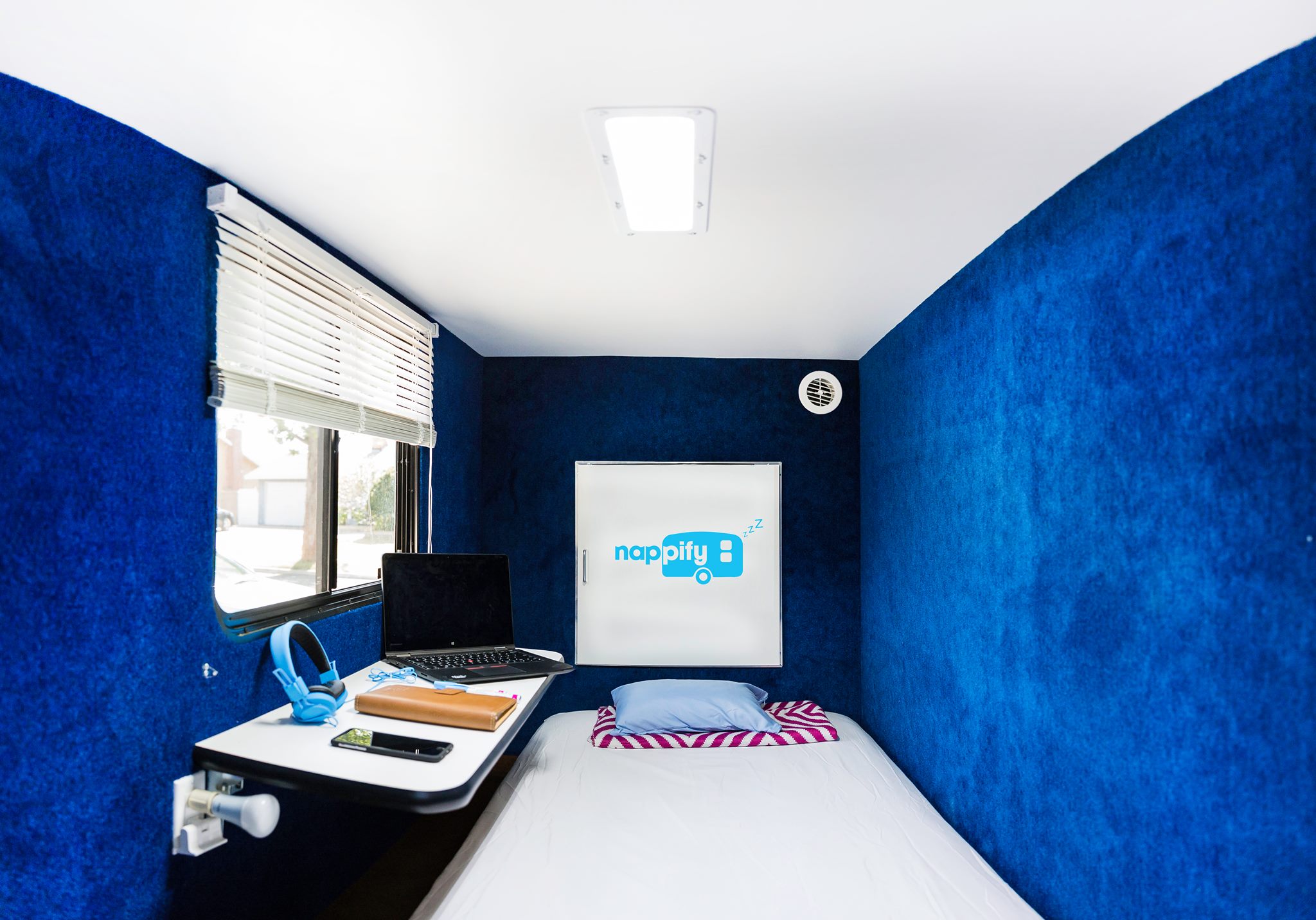
In other countries around the world, taking an afternoon siesta is not only an accepted practice but an encouraged one. Yet in America, the notion of workplace napping remains on par with measuring distance in kilometers: both things that just are not done here in these United States.
But one Orange County-based startup called Nappify is bravely setting out to change America’s perception of napping in public places in the middle of the day—with roving nap pods. “You take 30, 40 minutes to refresh yourself and then reenergize for the second half of the day,” says cofounder and CEO Kevin Pham, noting early on that fresh linens are brought in for each napper. (And, no, co-napping with a “friend” is not encouraged.)
The startup’s first “mobile nap station,” a 17-foot trailer that sleeps four in individual cubbies, launched in early June in a ceremony at Santa Ana College in Southern California. Pham says about three dozen people tested it out over a three-day trial, each paying $12.99 for 40 minutes of snoozing (or $15 total to tip the sheet-changing attendant). Each air-conditioned cubby is billed as big enough for a twin mattress and folding table. An emergency window comes equipped with blinds and, Pham says, sleepers are awoken by lighting systems when nap time is over.
The science is on his side, even if the culture is not. Medical research has found that naps help people relax, reduce fatigue, increase alertness, improve people’s moods and can even boost memory and reaction times. The practice Pham suggests—having a lie-down that is less than an hour to break up the work day—is close to the napping practices recommended by the Mayo Clinic. Though the clinic’s guidance notes that napping isn’t for everyone, they suggest that those who could use forty winks take them in the early afternoon for between 10 and 30 minutes, to minimize grogginess once the real world fades back in.
Some companies, particularly Google-types in Silicon Valley, have taken to installing stationary nap pods for their employees. Versions like the EnergyPod from MetroNaps, which Samsung recently installed in their U.S. headquarters, are billed more as high-tech chairs than beds and run about $13,000. Pham argues that many small businesses don’t have the money or the space for that kind of product and that leasing a nap pod in their parking lot for a month or two will allow them to try out power-napping as a “no-commitment option.” (He says they’re still working on those longer-term prices.)
This summer, Nappify plans to tour around Southern California, trying to build up buzz for the product and convert more Americans—hoping to convince people that mid-day napping is not a sign of laziness in a country that associates non-stop hard work with success, but rather the kind of thing smart, body-aware people do (and advise their employees to do) to increase their effectiveness. Studies have found that naps can boost job performance by a third and that poor sleep costs the U.S. north of $60 billion in human capital each year.
His mission is a tough one: Nappify is far from the first to proselytize Americans about mid-day sleeping, and the medical research has been out for some time without causing mass changes in the American workplace. Pham, who takes one 13-minute nap each day, says that his napping tour this summer is going to target college campuses in part so he can shape the minds of people who will be managers and business owners in the future. He has dreams that nap trailers like his could someday be found at airports, for those suffering from long layovers and delays, and dotted along public highways like rest stops so sleepy drivers can get reprieve.
“There is the misconception that a nap is … an ugly and unprofessional thing,” says Pham, who immigrated to the U.S. from Vietnam. “In America you have the coffee break or the energy drink.” But those just put off the symptoms of sleepiness, he says, while embracing sleeping at work can treat the root cause.
More Must-Reads From TIME
- The 100 Most Influential People of 2024
- The Revolution of Yulia Navalnaya
- 6 Compliments That Land Every Time
- What's the Deal With the Bitcoin Halving?
- If You're Dating Right Now , You're Brave: Column
- The AI That Could Heal a Divided Internet
- Fallout Is a Brilliant Model for the Future of Video Game Adaptations
- Want Weekly Recs on What to Watch, Read, and More? Sign Up for Worth Your Time
Contact us at letters@time.com